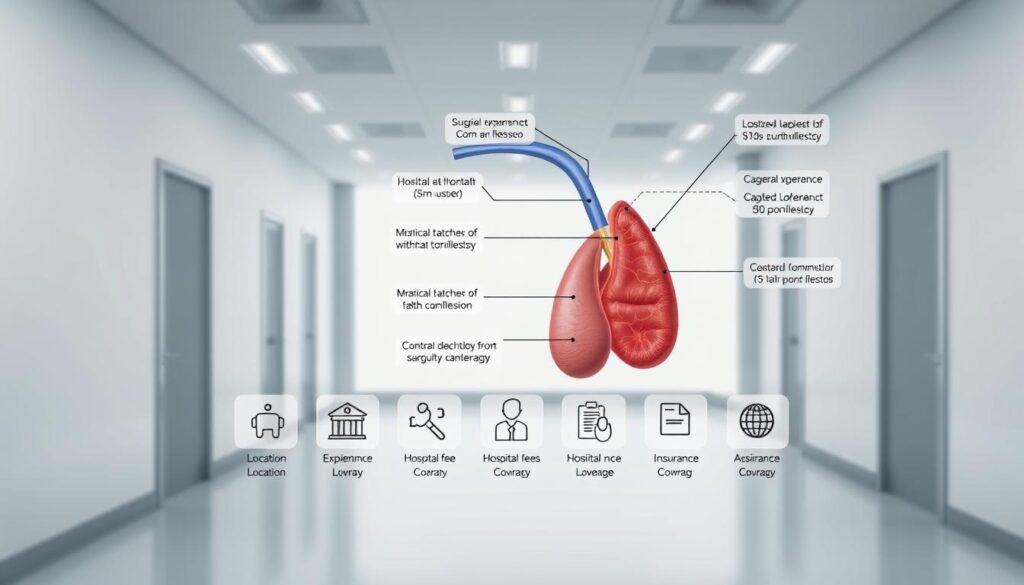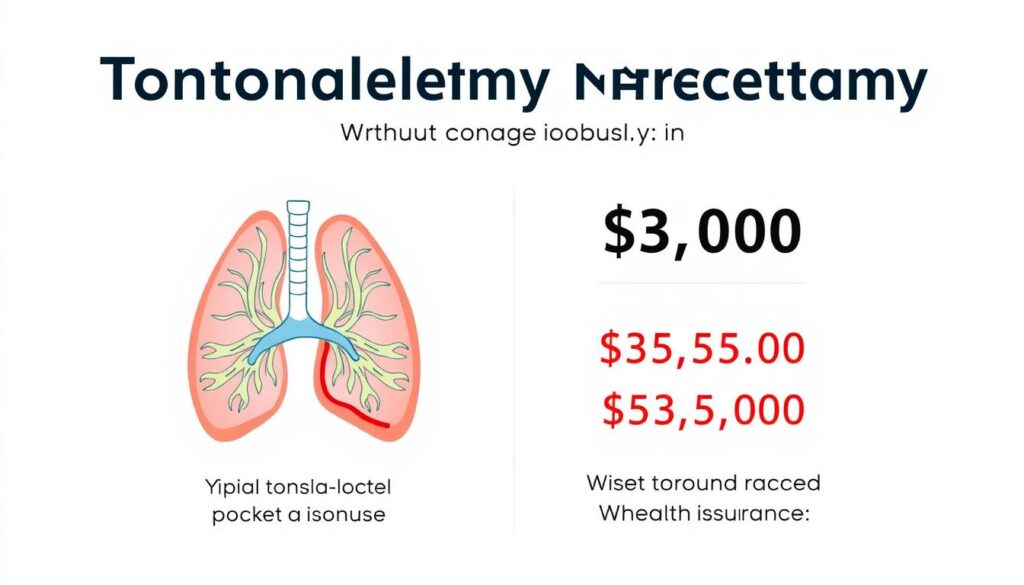Dealing with a tonsillectomy can be stressful, and the costs are a big worry. If you’re facing this situation without insurance coverage, knowing the expenses is key.
You might wonder what to expect and how to handle the costs. A tonsillectomy is a surgery to remove the tonsils. It’s important to understand the costs involved.
This guide will help you understand the cost of a tonsillectomy without insurance. We’ll show you how to prepare for the expenses and make smart choices about your care.
Key Takeaways
- Understanding the average cost of a tonsillectomy without insurance.
- Factors that influence the overall expense of the procedure.
- Options for managing the financial burden of a tonsillectomy.
- Tips for reducing costs and finding affordable care.
- What to consider when planning for a tonsillectomy without insurance.
Understanding Tonsillectomy: What You Need to Know
Learning about tonsillectomy is key if you’re facing this surgery. A tonsillectomy removes the tonsils, which are lymphoid organs at the back of the throat.
What Is a Tonsillectomy?
A tonsillectomy treats recurring tonsillitis or sleep issues like sleep apnea. It’s done under general anesthesia and takes about 30 to 45 minutes. Recovery can take a few days to a couple of weeks.
Common Reasons for Tonsil Removal
Tonsil removal is often for recurrent tonsillitis, or frequent tonsil inflammation. It’s also for sleep disorders like obstructive sleep apnea and sometimes peritonsillar abscesses. The choice to have a tonsillectomy comes after trying other treatments.
Knowing why tonsil removal is needed is vital. It helps you prepare for the surgery and recovery.
How Much Is Tonsil Removal Without Insurance?
Many people ask how much tonsil removal costs without insurance. The cost of a tonsillectomy can be high. It’s important to know the costs to make good choices about your health.
National Average Cost Range
The cost of tonsillectomy without insurance varies. It can range from $3,000 to $7,000. This price can change based on the surgery’s complexity, the surgeon’s fees, and where the surgery is done.
- Surgeon’s fees: $1,000 to $3,000
- Facility fees: $1,500 to $3,500
- Anesthesia fees: $500 to $1,500
These costs show why it’s key to think about all parts of the procedure when figuring out the total cost.
Regional Cost Variations Across the US
Healthcare costs can differ by region. For example, urban areas might have higher costs than rural areas. This is because of living costs and facility fees.

Cities like New York or Los Angeles might have higher costs for tonsillectomy. It’s smart to look up prices in your area. This way, you can find a good deal without sacrificing quality.
Learning about tonsil removal costs can help you plan better. Knowing both national averages and regional differences is key. It helps you prepare for the procedure financially.
Factors That Affect Tonsillectomy Costs
The cost of a tonsillectomy can change a lot based on several key factors. Knowing these can help you guess the total cost of your procedure.
Geographic Location and Local Market Rates
The cost of a tonsillectomy can be affected by where you live. Cities usually have higher medical costs than rural areas. This is because of local market rates and the cost of living.
For example, a tonsillectomy in New York City or Los Angeles might cost more. This is compared to smaller cities or towns.
Hospital vs. Outpatient Surgical Center
Choosing between a hospital or an outpatient surgical center can also change the cost. Hospitals usually charge more because of their high overhead costs. Outpatient centers, though, can be cheaper without sacrificing quality.
Surgeon Experience and Specialization
The experience and specialization of your surgeon also play a role. More experienced or specialized surgeons might charge more. But, their skills can lead to better results and fewer complications. This could save you money in the long run.

Breaking Down the Expenses of Tonsil Removal
The cost of removing tonsils includes several parts. Knowing these can help you understand your expenses better. This way, you can manage your healthcare costs more effectively.
Surgeon Fees and Professional Services
Surgeon fees are a big part of the cost. They cover the surgeon’s work before, during, and after surgery. The complexity of the surgery and the surgeon’s experience can affect these fees.
Anesthesia Costs and Personnel
Anesthesia costs are also important. They include the anesthesiologist’s fees, medications, and equipment. The type of anesthesia and the surgery’s length can change these costs.
Facility Fees and Operating Room Charges
Facility fees cover the use of the operating and recovery rooms. These fees vary by location and facility type. They also include costs for equipment and staff in the operating room.
Understanding these parts helps you estimate your surgery’s total cost. This knowledge lets you make better decisions about your care.
Comparing Costs: Tonsillectomy With vs. Without Insurance
It’s important to know the costs of tonsillectomy with and without insurance. This knowledge helps you make better choices. Insurance can greatly affect how much you pay for a tonsillectomy.

Average Costs With Different Insurance Plans
The cost of tonsillectomy with insurance changes based on your plan. Plans with higher deductibles and copays might cost less each month. But, you’ll pay more when you get the surgery.
On the other hand, plans with lower deductibles and copays cost more each month. But, you’ll pay less when you have surgery. Insurance usually covers 50% to 80% of the costs. You’ll have to pay the rest.
Deductibles, Copays, and Out-of-Pocket Maximums
Deductibles, copays, and out-of-pocket maximums are key parts of your insurance. A deductible is what you pay before insurance starts. Copays are fixed costs for certain services. Out-of-pocket maximums are the most you’ll pay for healthcare each year.
Knowing these can help you get ready for tonsillectomy costs. It’s all about understanding your insurance to avoid surprises.
Payment Options for Uninsured Patients
The cost of tonsillectomy can be overwhelming for those without insurance. But, there are many payment solutions to help. It’s important for uninsured patients to know their options to manage costs.
Medical Credit Cards and Healthcare Loans
Medical credit cards and healthcare loans are good for financing tonsillectomy. They let you pay upfront and then in monthly installments. Cards like CareCredit and Prosper Healthcare Lending offer 0% interest for a while, making payments easier.
Hospital Payment Plans and Financial Counseling
Hospitals have payment plans for tonsillectomy. These plans let you pay in installments, easing financial stress. They also offer financial counseling to help with payment options and possible financial aid.
Health Savings Accounts (HSAs) and Flexible Spending Accounts (FSAs)
Even without insurance, some can use HSAs or FSAs for medical costs. These accounts offer tax benefits, lowering healthcare costs.

| Payment Option | Description | Potential Benefits |
|---|---|---|
| Medical Credit Cards | Specialized credit cards for medical expenses | 0% interest promotional periods, flexible payment plans |
| Hospital Payment Plans | Installment plans offered by hospitals | Reduces immediate financial burden, manageable monthly payments |
| HSAs/FSAs | Savings accounts for medical expenses with tax benefits | Tax advantages, long-term savings |
Financial Assistance Programs for Tonsillectomy
If you’re facing a tonsillectomy without insurance, there are several financial assistance programs you can explore. These programs can significantly reduce the financial burden, making the procedure more accessible.
Hospital Charity Care and Financial Aid Programs
Many hospitals offer charity care or financial aid programs for patients who cannot afford their medical bills. These programs often have eligibility criteria based on income levels. Some hospitals may offer sliding scale fees. You can contact the hospital’s billing department or patient advocacy group to inquire about available programs and the application process.
Nonprofit Organizations and Patient Advocacy Groups
Several nonprofit organizations and patient advocacy groups provide financial assistance or guidance for individuals undergoing tonsillectomy. These organizations may offer grants, help with navigating the healthcare system, or provide resources for finding affordable care. Researching and reaching out to these groups can be a valuable step in securing financial aid.
State and Federal Assistance Options
Depending on your location and financial situation, you may be eligible for state or federal assistance programs. Medicaid, for example, can cover tonsillectomy costs for eligible individuals. Some states have specific programs for low-income individuals or those with certain medical conditions. Investigating these options can provide significant financial relief.
By exploring these financial assistance programs, you can find help to manage your tonsillectomy costs. It’s essential to research and reach out to these resources to understand the eligibility criteria and application processes.
How to Negotiate Lower Tonsillectomy Costs
You don’t have to spend a lot to get a tonsillectomy. Learning to negotiate can save you a lot of money. It might seem scary, but it’s a good way to cut down on costs.
Requesting Cash Discounts and Self-Pay Rates
Many doctors offer cash discounts or self-pay rates for those without insurance. These deals can greatly reduce what you pay. Always ask if they have any self-pay options.
Comparing Prices Between Providers and Facilities
It’s important to compare prices. Here’s a look at average tonsillectomy costs at different places:
| Facility Type | Average Cost | Range |
|---|---|---|
| Hospital | $10,000 | $8,000 – $12,000 |
| Outpatient Surgical Center | $6,000 | $5,000 – $8,000 |
| Specialty Clinic | $7,500 | $6,000 – $9,000 |
By looking into prices, you can choose what fits your budget. Always ask about cash discounts or self-pay rates when talking to doctors.
Preparing Financially for Your Tonsillectomy
Getting ready for a tonsillectomy means more than just knowing the procedure. It’s also about planning your finances carefully. This way, you can avoid any unexpected costs.
Essential Questions to Ask Before Surgery
Before your tonsillectomy, ask your doctor some key questions. This will help you understand the costs involved. Here are some important ones:
- What are the total costs for the surgery, including surgeon fees and facility charges?
- Are there any additional costs for anesthesia, medications, or follow-up care?
- What payment options are available for uninsured patients or those with high deductibles?
By asking these questions, you can create a more accurate budget. This helps you avoid any surprises.
Creating a Comprehensive Medical Expense Budget
To get ready financially, you need to make a detailed budget. This should include all possible costs for your tonsillectomy. Here are some expenses to consider:
| Expense Category | Estimated Cost |
|---|---|
| Surgeon Fees | $1,500 – $3,000 |
| Facility Charges | $1,000 – $2,500 |
| Anesthesia | $500 – $1,000 |
| Medications and Follow-up | $200 – $500 |
Knowing these costs helps you plan your finances better. Make sure to save extra for any unexpected needs or extra care.
Additional Costs During Tonsillectomy Recovery
Recovering from a tonsillectomy comes with extra expenses. The recovery time can be as costly as the surgery itself.
Prescription Medications and Pain Management
You might need pain meds after surgery. The cost depends on your insurance and the doctor’s prescription. You might also need meds for nausea or infection.
Follow-up Appointments and Possible Complications
Regular check-ups with your doctor are important. They help track your healing but add to the cost. If complications happen, you might face more expenses.
Lost Income and Time Off Work Considerations
Recovering from a tonsillectomy often means missing work. This can hurt your finances, more so if you’re the main earner or have little sick leave.
Knowing these extra costs helps you prepare financially for your surgery and recovery.
Conclusion
Knowing the costs of a tonsillectomy is key for good financial planning. The price can change a lot based on where you live, the type of surgery center, and the surgeon’s experience.
To handle these costs, look into different payment choices. This includes medical credit cards, healthcare loans, and hospital payment plans. You might also find help from hospital charity care or nonprofit groups to lower your bills.
When getting ready for your surgery, think about more than just the surgery cost. You’ll also need to pay for medicines and doctor visits after you’re home. Knowing what your insurance covers and planning your medical costs can help you manage better.
By understanding the main points and options, you can make smart choices about your tonsillectomy. This will help make the financial part easier.
FAQ
How much does a tonsillectomy cost without insurance?
Without insurance, a tonsillectomy can cost between ,000 and ,000. This price varies based on where you are, the surgeon’s fees, and the facility’s charges.
What is the average cost of tonsil removal with insurance?
With insurance, the cost drops. It usually ranges from 0 to ,000. This depends on your insurance, deductibles, copays, and out-of-pocket maximums.
How much does it cost to remove tonsils without insurance?
Without insurance, removing tonsils can cost a lot. It’s often between ,000 and ,000. This price changes based on your location, the surgeon’s experience, and the facility’s fees.
Are there any financial assistance programs available for tonsillectomy?
Yes, there are programs to help. These include hospital charity care, nonprofit groups, and state and federal aid. They can help cover the cost of a tonsillectomy for those without insurance.
Can I negotiate the cost of tonsillectomy?
Yes, you can try to lower the cost. Ask for cash discounts, compare prices, and look into payment plans and financial advice.
What additional costs should I expect during tonsillectomy recovery?
Recovery can add extra costs. You might need to pay for medications, pain management, follow-up visits, and possible complications. You could also lose income from missing work.
How can I prepare financially for my tonsillectomy?
To get ready financially, ask important questions before surgery. Make a detailed budget for medical expenses. Look into payment options like medical credit cards, hospital plans, and health savings accounts.
What factors affect the cost of tonsillectomy?
Several things affect the cost. These include where you are, the surgeon’s experience, facility fees, anesthesia costs, and local rates.

